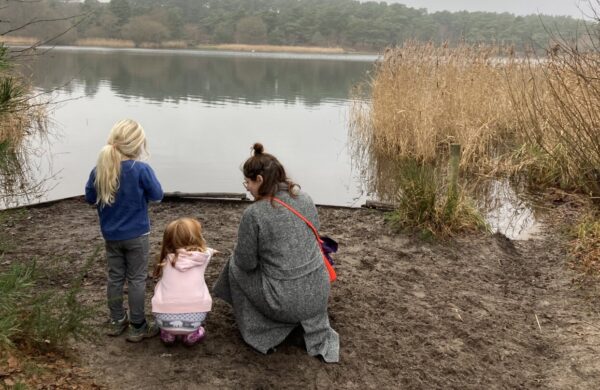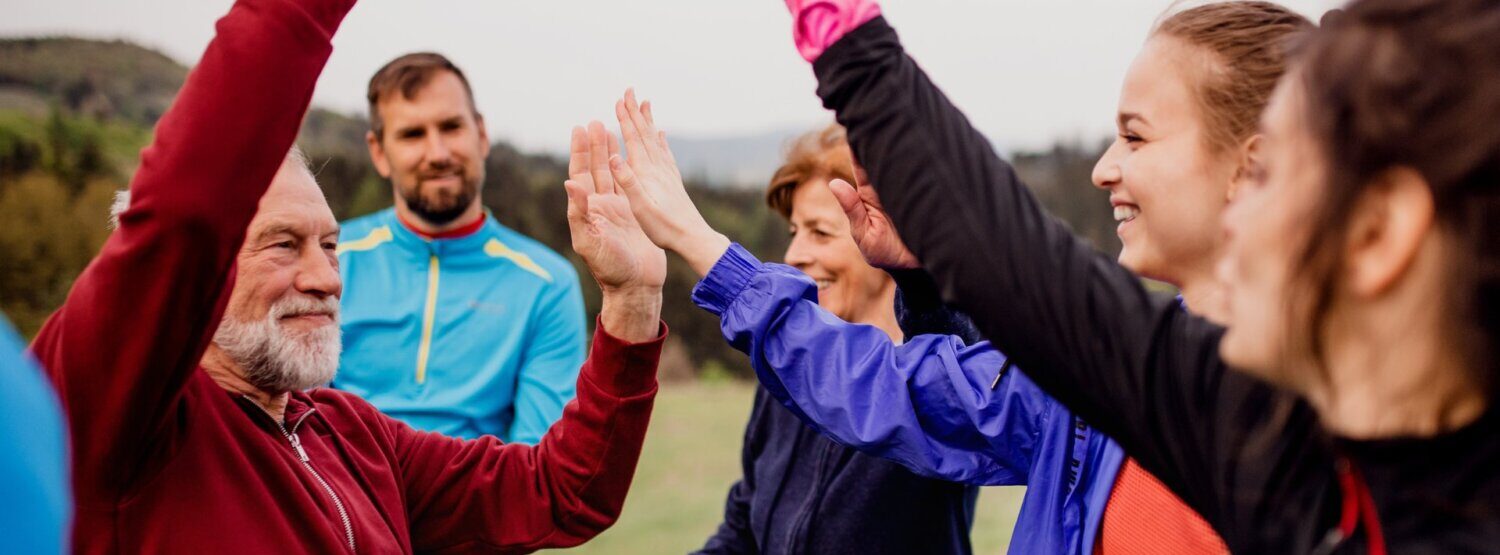
Physical Activity As Family Time
Catherine enjoys getting active with her family.

There were weeks when I wanted nothing more than to stay in bed but with the encouragement of my mum I went [to circuits]. On those days I always felt so much better.
Georgia, Southampton
If it was as easy as saying “just do it” then everyone would be active. But low confidence, fear of judgement, fear of making a health condition worse, bad previous experiences and not knowing where to start are all barriers to an active life.
So, how can you start the conversation?
If your loved feels bombarded or pressured, it’s unlikely they’ll take action. Therefore, it’s important to ease into the topic of physical activity. You could talk about:
Top Tip: After you’ve opened the conversation, use open questions to follow up. This could be:
However you choose to open the conversation, the next step is about understanding what’s stopping your loved one from moving more.
Why is this important?
By understanding the barrier, you can overcome it! If your loved one is afraid that they won’t know what they’re doing, look at a beginner-only courses. If your loved one is afraid that they won’t like something or don’t want to commit long-term, find an activity with a free taster session. If your loved one is worried about health flare-ups, find a group specifically for those with the same health condition.
Trust us when we say: there is a physical activity out there to suit everyone. To find the right opportunity, you need to know what it is your loved one is looking for.
When you say ‘physical activity’ people often think about sports first – football, cricket, basketball. But physical activity is everywhere!
It’s going outside to photograph the birds, it’s parking further away from the shops or choosing the stairs instead of the escalator, it’s doing the house chores with a little more oomph! You may find your loved one is already doing some of this but didn’t think it counts as activity. It absolutely does!
It’s also important to remember that physical activity doesn’t have to be one long hour stint in the gym, it can be 5 minutes of stretching before you brush your teeth, 5 minutes dancing to your favourite song before hopping in the shower, squatting while boiling the kettle – all of this is living a more active life.
We’ve all heard that exercise is good for you, but why exactly? Yes, it can improve sleep, it can strengthen your bones and muscles, and lower your risk of developing depression. But these benefits take a while to notice. Instead, focus on:
Our ‘Why You Should Be Active’ webpage goes into much more detail if you’re interested!
One of the most successful ways to get your loved one moving may be to join the class yourself and take them with you. Even if they sit on the side for the first session, that’s okay. Even if they sit on the side the second session, that’s okay.
But it is a lot easier to get active when you have someone there to laugh with and lean on.
If my partner hadn’t gone inside the village hall with me, I would have turned around and gone home. I was so scared I was going to go into the wrong room. He led me to the right place and kept me company the whole session which gave me the confidence to introduce myself to others.
Bethany, Hampshire Resident
Your friends and family are lucky that you’re looking out for them. Even if they don’t recognise it yet, they will when they’re moving more and feeling better for it. Here’s our top tips to encouraging your loved one to move more.
One of the simplest ways to encourage your loved ones to move more is to model active behaviour. Tell them what you’ve been up to and how it made you feel, or share regular posts about being active on social media if you’re going for an indirect approach.
However you choose to share your experiences, make sure you keep it real. It’s important for your friends and family to know that they don’t need to be perfect or ‘good at it’ to be active.
Little steps lead to big changes over time. Encourage your loved one to begin with just 5 or 10 minutes a day – maybe a short walk to the shop, some gentle stretching in the morning, or even dancing around the kitchen to their favourite song. These short bursts of movement can boost their confidence and show them that being active doesn’t have to be intimidating.
It’s all about building the habit, not doing it perfectly. Let them go at their own pace. Some days will be easier than others, and that’s okay. What matters is showing up and trying – even a little bit counts.
Think of ways to build movement into the time that you spend together. If you normally meet for a drink or food, try going for a walk instead or combining a walk and a meal.
If you live together and watch a lot of TV, set yourself an ad break movement challenge. Or switch 30 minutes of TV watching for an online workout instead.
Our ‘How To Be Active’ section of our website has lots of different activities that you could try!
If being active really isn’t their thing then joining a charity challenge could help shift the focus. Some people find that supporting a charity they care about provides that little extra motivation they need to get started.
Otherwise, hobbies like photography or litter picking can be great for getting outdoors and walking without thinking of it as exercise. Think of something they enjoy that could include movement.
For your own piece of mind and your loved ones’ safety, you’ll want to check that the activity they are joining is well run and safe. Below you’ll find advice and resources to help you navigate safeguarding issues.
It covers the questions you might have when considering a new activity, as well as things to look out for. We’ve also included practical advice of what to do if you are concerned for a loved one’s safety.
All clubs and organisations should have certain things in place to make sure that all participants are kept safe and looked after throughout sessions.
Organisations should be open and happy to share their policies with you. You have a right to know this information.
They should:
There are some questions you can ask to establish if an activity is right for your friends and family. These can help you find out how the club or organisation is prepared to prevent harm or risk.
There are a number of different things to look out for when protecting friends and family taking part in physical activity. If an activity provider does not have the previously listed policies and procedures in place this is a sign of poor practice and they are not demonstrating how they are prioritising welfare and safeguarding.
Signs of an activity being unsafe are:
If you are worried an individual is at risk and being abused or harmed during sports activities, it’s important that you talk to someone.
Talking to someone may be a daunting experience but by sharing your concern you are protecting the individual at risk. The person you talk to will be trained to deal with such situations and is there to help you.
All clubs should have guidelines for recording and reporting concerns. You should find out what these are and follow them by speaking in the first instance to the Club welfare or child protection officer.
Who to contact for help:
Local authority contacts:
If you’re unsure who to speak to, you can call the NSPCC on 0808 800 5000 for advice or contact the Child Protection in Sport Unit on 0116 366 5580.
Visit our safeguarding resources and guidance webpage for more information about safeguarding Children and Young People or Vulnerable Adults.
CPSU Information for Parents
Advice and guidance so you can make sure your child and other children are having the best experiences of sport.
Sport England Advice for Parents and Carers
Cover the key points you should consider when choosing a sports club, coached session or activity.
Energise Me makes no claim or representation regarding, and accepts no responsibility for, the quality, content, nature, reliability or safety of third party websites. Likewise for services accessible by hyperlink (“Links”) from any webpage on the Energise Me website https://www.energiseme.org/ (“Website”) or third party websites linking to the Website.
Such linked websites are not under Energise Me’s control. Energise Me is not responsible for the content of any such linked websites and/or any link contained in a linked website, or any review, changes or updates to such websites. Energise Me provides these Links to you only as a convenience and/or for educational purposes. The inclusion of any Link does not imply any affiliation, endorsement, or adoption by Energise Me of the website or any information contained in it. When leaving the Website, you should be aware that Energise Me’s Terms and Conditions no longer apply, and, therefore, you should review the applicable terms and policies, including privacy and data gathering practices, of any third party website.